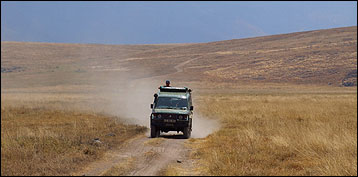Safari guide & driver mistakes
 Automatically blaming
your guide for not spotting
all the major animals
Automatically blaming
your guide for not spotting
all the major animalsSome wildlife is not easy to spot
Wildlife doesn't appear on cue. If the trained and sharp eyes of a nearby predator are unable to spot a camouflaged animal or bird, then how can we expect the less endowed eyes of your guide (even with binoculars) to do so?
Animal count
Don't judge your guide just on how many different animals and birds he spotted. Wildlife is not confined in a zoo (on safari you are the one in the cage - the vehicle).
Under tipping your guide and driver
The need to tip app
Most safari guides and drivers receive meager wages. They depend on tips for their livelihood.
Tipping guidelines
Seasoned travelers tip their safari guides (or guide-drivers) approximately $7 to $20 per day per person, depending on their guides' overall performances and the size of their parties. Tip the driver about $5 to $10 per day. If you are on a packaged tour, ask the tour operator for its recommendation.
Not considering the possibility of having a guide-driver instead of a guide and driver
Benefits either way
There are strong benefits in paying extra to have a separate guide and driver instead of a single guide-driver.
However, if there will be only 2 to 4 people in your vehicle, be at least aware of the several benefits in using a solo guide-driver:
- Use of front passenger seat
The guide occupies the seat next to the driver. This is a choice place for viewing as you drive through the game reserves. If you have a combined driver-guide, you can alternate the use of that front seat with your vehicle mates. - Knowledge level
True, a guide specialist is usually (but not always) more apt to be more knowledgeable than a driver-guide. However, the difference in his knowledge may be valuable to only someone interested in learning academic details. - Cost
You will save money, sometimes a substantial amount.


